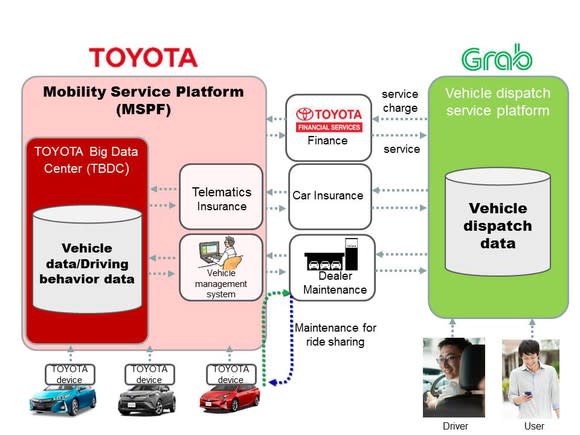Why Toyota Just Made a Billion-Dollar Bet on Ride-Hailing
Toyota Motor Corporation (NYSE: TM) said on Wednesday that it has agreed to invest $1 billion in Grab Taxi Holdings, a ride-hailing company based in Singapore.
It's the largest investment in ride hailing made by an automaker to date. While Grab isn't exactly a household name in the United States, it's not a tiny start-up: It has operations in eight countries, and (with this deal) it's now valued at just over $10 billion.
Clearly, this is a big move for Toyota. Here's what we know.

Singapore-based Grab operates mobility services in eight Southeast Asia countries. Image source: Grab Taxi Holdings.
An expansion of an existing partnership
In a statement, Toyota said the deal with Grab is intended to "drive further advances in Mobility as a Service (MaaS) across the region," meaning Southeast Asia. In exchange for its $1 billion investment, Toyota will get a seat on Grab's board of directors, and a Toyota employee will be "seconded to Grab as an executive officer," the company said.
Toyota has been working with Grab since August 2017, when the two began work on connected services for Grab vehicles using a Toyota-developed system. The system has helped Grab provide insurance for its rental fleet in Singapore with rates based on actual driving data recorded by the Toyota system.
With this investment, Toyota and Grab will expand the connected services to Grab's fleet across Southeast Asia, which will then allow the two to roll out a series of services (like the insurance) that rely on the data collected by the Toyota system. The two may also collaborate on financing and maintenance offerings for Grab drivers as well, they said.
Why Toyota wanted a big stake in Grab
Toyota's move to invest in Grab was probably motivated by a few factors.
First, Southeast Asia is a very important market for Toyota. Toyota's Asia unit sold just over 1.5 million vehicles in the fiscal year that ended on March 31, a figure that doesn't include sales in Japan or China, but does include a lot of vehicles sold in the countries where Grab is active. Here's what Toyota's sales looked like in calendar year 2017 in the countries in which Grab operates.
Nation | Toyotas Sold in 2017 | Toyota's Market Share in 2017 |
|---|---|---|
Indonesia | 371,332 | 34.4% |
Malaysia | 69,492 | 11% |
Phillipines | 182,657 | 38.5% |
Singapore | 19,153 | 21% |
Thailand | 239,551 | 27.5% |
Vietnam | 59,355 | 21.8% |
TOTAL | 941,520 | - |
Data source: Best Selling Cars Blog. Sales totals and market share are for calendar year 2017. Data for the other two countries in which Grab operates, Cambodia and Myanmar, was not available.
Second, Toyota may have wanted to block rivals from taking larger positions in Grab. Honda (NYSE: HMC) and Hyundai (NASDAQOTH: HYMTF) have both made smaller investments in Grab, Honda in 2016, and Hyundai earlier this year. And SoftBank Group took a stake in Grab last year, one of several major investments it has made in ride-hailing companies around the world. SoftBank isn't exactly a Toyota rival, but its investment may have grown in significance for Toyota after SoftBank's Vision Fund announced a $2.25 billion investment in General Motors' (NYSE: GM) self-driving taxi subsidiary earlier this month.
Why is that important? Ride-hailing companies are likely to be important early customers for self-driving vehicles. GM is preparing to begin mass-producing a self-driving urban taxi based on its electric Chevrolet Bolt for deployment next year, and SoftBank's investment in GM Cruise gives it a direct link to Grab.
Given that Toyota has a fairly advanced self-driving research-and-development effort of its own underway, it may have made this move in part to ensure that it will continue to be a major player in a region important to its business as self-driving taxis become commonplace -- or put another way, to ensure that its own self-driving vehicles are at the top of Grab's eventual shopping list.

Toyota released this graphic showing how it will collaborate with Grab. Image source: Toyota.
The upshot: Toyota is positioning itself for an industry upheaval
Ride-hailing and self-driving are two of several technologies that threaten to disrupt the existing global auto industry. It's likely that not all of the legacy automakers will thrive in the new world of shared, automated mobility.
With a substantial stake in Lyft and an advanced self-driving effort, General Motors has done more than most of the big automakers to prepare for that coming world. Toyota's investment in Grab should help ensure that the Japanese giant will be able to keep pace with its old Detroit rival.
More From The Motley Fool
Suzanne Frey, an executive at Alphabet, is a member of The Motley Fool's board of directors. John Rosevear owns shares of General Motors. The Motley Fool owns shares of and recommends Alphabet (A and C shares). The Motley Fool has a disclosure policy.

 Yahoo Finance
Yahoo Finance 